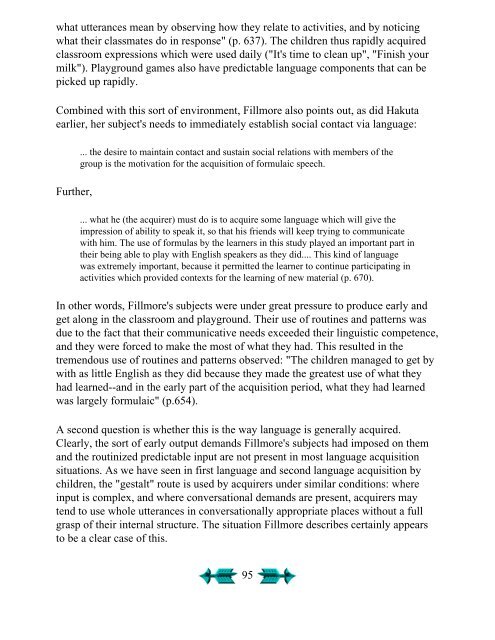Second Language Acquisition and Second ... - Stephen Krashen
Second Language Acquisition and Second ... - Stephen Krashen
Second Language Acquisition and Second ... - Stephen Krashen
You also want an ePaper? Increase the reach of your titles
YUMPU automatically turns print PDFs into web optimized ePapers that Google loves.
what utterances mean by observing how they relate to activities, <strong>and</strong> by noticing<br />
what their classmates do in response" (p. 637). The children thus rapidly acquired<br />
classroom expressions which were used daily ("It's time to clean up", "Finish your<br />
milk"). Playground games also have predictable language components that can be<br />
picked up rapidly.<br />
Combined with this sort of environment, Fillmore also points out, as did Hakuta<br />
earlier, her subject's needs to immediately establish social contact via language:<br />
Further,<br />
... the desire to maintain contact <strong>and</strong> sustain social relations with members of the<br />
group is the motivation for the acquisition of formulaic speech.<br />
... what he (the acquirer) must do is to acquire some language which will give the<br />
impression of ability to speak it, so that his friends will keep trying to communicate<br />
with him. The use of formulas by the learners in this study played an important part in<br />
their being able to play with English speakers as they did.... This kind of language<br />
was extremely important, because it permitted the learner to continue participating in<br />
activities which provided contexts for the learning of new material (p. 670).<br />
In other words, Fillmore's subjects were under great pressure to produce early <strong>and</strong><br />
get along in the classroom <strong>and</strong> playground. Their use of routines <strong>and</strong> patterns was<br />
due to the fact that their communicative needs exceeded their linguistic competence,<br />
<strong>and</strong> they were forced to make the most of what they had. This resulted in the<br />
tremendous use of routines <strong>and</strong> patterns observed: "The children managed to get by<br />
with as little English as they did because they made the greatest use of what they<br />
had learned--<strong>and</strong> in the early part of the acquisition period, what they had learned<br />
was largely formulaic" (p.654).<br />
A second question is whether this is the way language is generally acquired.<br />
Clearly, the sort of early output dem<strong>and</strong>s Fillmore's subjects had imposed on them<br />
<strong>and</strong> the routinized predictable input are not present in most language acquisition<br />
situations. As we have seen in first language <strong>and</strong> second language acquisition by<br />
children, the "gestalt" route is used by acquirers under similar conditions: where<br />
input is complex, <strong>and</strong> where conversational dem<strong>and</strong>s are present, acquirers may<br />
tend to use whole utterances in conversationally appropriate places without a full<br />
grasp of their internal structure. The situation Fillmore describes certainly appears<br />
to be a clear case of this.<br />
95











